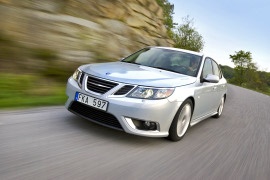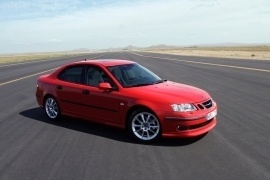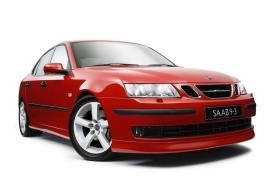
SAAB 9-3 Sport Sedan
Generations Timeline, Specs and Pictures

The 2009 9-3 series expands the trim levels while dropping the limited-edition Turbo X sedan and wagon from the lineup.
The 2.0T and some of the Aero models are now available with Saab’s all-wheel drive(XWD). The new Saab 9-3 is virtually unchanged from the 2008 model, to which where brought many design and performance enhancements. During 2009 the 9-3X was launched at the Geneva auto show. The 9-3X is a four wheel drive XUV version of the 9-3 SportCombi.The Saab 9-3 is available with four-door saloon body (Sport Sedan), family (Sport Hatch) and cabriolet (convertible).

In 2008, Saab unveiled the Turbo X as the ultimate performance version for the 9-3 range and the top-performer model for the Swedish carmaker family.
While the world economic crisis started to take its toll among the carmakers, Saab struggled to survive. Its cars were already too expensive for the market, and its sales plunged. The carmaker needed a desperate move and charged with a unique version of the 9-3 range: the Turbo X. It showed up late, in the autumn of 2007, exactly three decades after the unveiling of the 900 Turbo, at the Frankfurt Motor Show, in two body versions: sedan and station wagon.
Its look was distinctive compared to the rest of the range. First of all, it was available only in metallic jet black, with the front grille and all exterior detailing accented in a matte gray titanium-like finish. It represented an updated interpretation of the 900 Turbo, the first turbocharged production vehicle sold by Saab. Unlike the rest of the 9-3 range, the Turbo X featured different front and rear bumpers, with silver adornments around the fog lights and rear diffuser. From its sides, the 18” light-alloy wheels sported a unique design.
Inside, the 9-3 Turbo X featured an instrument panel with three large dials. The speedometer took the center stage flanked by the tachometer on the left and a specific dial on the right, which showed a turbo-gauge like the 900 Turbo, the fuel level, and the coolant temperature.
Under the skin, the carmaker installed a turbocharged V-6 engine paired with a six-speed manual, which sent the power in all corners via an intelligent all-wheel-drive system. That distributed the torque between the front and rear axles and the left and right rear wheels thanks to an electronically controlled limited-slip differential.

Saab was under the GM umbrella when it introduced the second generation of the 9-3 range as a compact sedan with a sporty and premium character.
General Motors desperately tried to make the Swedish brand profitable because they were bleeding money. For that, they granted them the platform from a Vauxhall/Opel Vectra and Cadillac BLS, telling them to build a car on top of that, but with minimal changes. Saab considered that the platform was too weak to meet its safety standards. In the end, the 9-3 shared only 30% of the parts with other GM vehicles.
From the outside, there was a specific design. Saab shared didn’t share any body panel with its siblings. Its headlights sported an angular design with a Saab-specific grille between them. Also, the wrapped-around bumper featured an apron extended forward. In a collision with a pedestrian, that design lifts the person above the car, not underneath. Later on, that measure was implemented and mandatory on most European vehicles, but Saab did it in 2002.
Inside, Saab didn’t take any switch or button from the GM parts bin. Not even the infotainment unit. Saab did a better job for that, but more expensive. Its key-fob mounted between the front seats was a signature feature for the Swedish brand. The center stack formed together with the instrument panel a surrounding area for the driver. For the Aero trim level, the sport bucket-seats with high bolstering were standard.
Under the hood, Saab installed a unique turbocharged 2.8-liter engine. Later on, Opel/Vauxhall carried that over on the Insignia OPC/VXR. But when Saab introduced it, it was too expensive for the market. It sent its power to the front wheels via a six-speed gearbox, either manual or automatic.

The 2003 Saab 9-3 Sport Sedan is, just like its name suggests, the sports version of the 9-3 model launched during the same year.
Advanced aerodynamics, redesigned grille and headlights, re-shaped windows and coupe-like body style are only a few elements which improve both the look and the performance of the new car. The Sport Sedan comes in multiple engine configurations, starting with the 1.8i 122 horsepower and ending with the 2.2 TiD 125 horsepower. The top engine in the Sport Sedan line-up is the 2.0-liter TS which produces 210 horsepower and a maximum speed of 235 km/h.

The 1998 Saab 9-3 was an evolution over the previous 900 series, especially regarding design, but a completely new vehicle from the platform point of view, which was a “cousin” of the European Opel Vectra.
The unusual look of the car, with a sloped rear, was a Saab brand signature.
Inside the vehicle, some of the aviation-inspired features were kept and some others were added. For instance, the ignition key was placed between the front seats, next to the handbrake. The dashboard had a “night” mode, where only the speedometer was illuminated during the night to decrease the effort for the driver. The Swedish engineers worked hard to offer a Swedish car even if underneath it was a GM platform.
The engines were mainly 2.0-liters with outputs ranging between 130 and 205 hp. Only the base version was naturally aspirated. The 150hp, 154hp, 185hp and 205hp are all turbocharged. The top-performer is called “Viggen” (Thunderbolt) and borrowed its name from the Saab Viggen fighter-jet.
Saab introduced low-pressure turbochargers to increase the torque at low revs and decrease fuel consumption. The transmissions offered on the 9-3 were either a 5-speed manual or a 4-speed automatic. The 9-3 Viggen had a 0-100 kph (0-62 mph) sprint in 6.4 seconds and a top speed of 249 kph (154.9 mph).
It worth mentioning that Saab 9-3 was the first car in the world to receive a 5 star EuroNCAP rating at the European crash-tests.























































